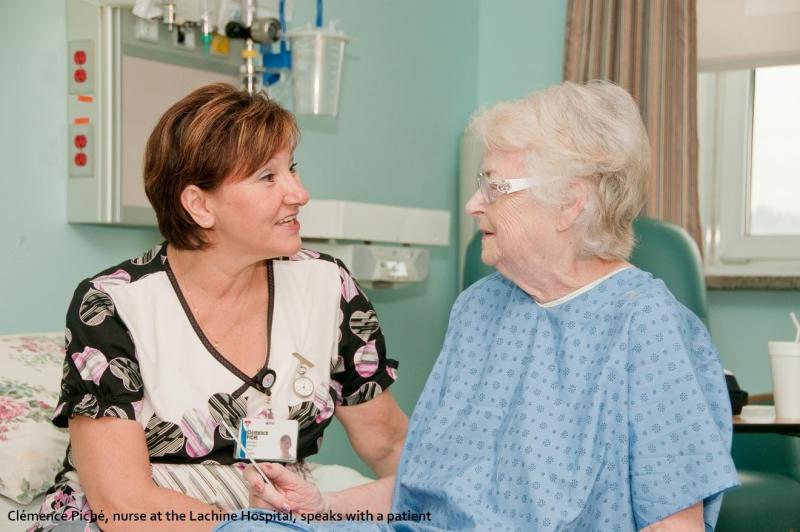Maximizing health for our ageing population

Clémence Piché, nurse at the Lachine hospital, speaks with a patient.
At the McGill University Health Centre (MUHC), over 45 per cent of patients were 65 years old and over last year. This number will only continue to climb.
The growth in our ageing population can be seen as a success story for public health policies and for socioeconomic development, but it also challenges society to adapt to maximize the health of older people. At the MUHC we are doing our part by ensuring we get it right as we transition to the Glen site in 2015.
“In Quebec, the Ministry of Health developed a program called the Approche adaptée à la personne âgée (AAPA). All hospitals in the province are being asked to implement the guidelines of this project,” says Rita Crisante, management advisor of the Development of the MUHC Elderly Friendly Project.
The four dimensions of AAPA include:
• clinical (revising care processes to decrease the risks of delirium and functional decline during hospitalization of older patients)
• physical environment (design strategies of care space to promote autonomy)
• social behaviour climate (reducing ageism towards the elderly)
• adapting policies and procedures to facilitate continuity of care.
“Some of our front-line staff will have access to 20 hours of e-training relating to the quidelines,” says Ms. Crisante. “I think there are many things to be learned. For example, The Canadian Malnutrition Task Force identified that a large number of older patients arrive at hospitals malnourished. We need to create awareness around this and readjust our clinical practices, as well as ensure that the physical design provides the appropriate environment. The developmental needs of the older patient requires a paradigm shift similar to what has been done for the pediatric population.”
In February, a pilot project will start on Ross 5 at the Royal Victoria Hospital (RVH), where the AAPA guidelines will be implemented. In March, the same will be done on 6 and 10 Medical at the Royal Vic and in the Emergency Departments of the RVH, Montreal General and Lachine hospitals.
Besides the training, a GAP analysis (looking at the gap between current practices and evidence-based practices provided by the Ministry) will be performed.
In all units, physical design will also be considered, such as making sure corridors are clear and carts are on one side, among other changes. At the Glen, the physical surroundings will be adapted from the start.
The social climate will come with time and sensitization. Ms. Crisante is currently working with Human Resources to make part of this awareness a module of orientation for new staff. And policies and procedures will contribute to the final implementation. It is expected that the MUHC will be fully Elderly Friendly Care recognized before the move to the Glen.
“Besides reducing length of stay, reducing the number of patients requiring rehabilitation or long-term care and increasing survival rates, these adaptations will contribute to overall safety and quality of care,” says Ms. Crisante. “And as we all would want for our ageing family members—overall improved quality of life.”